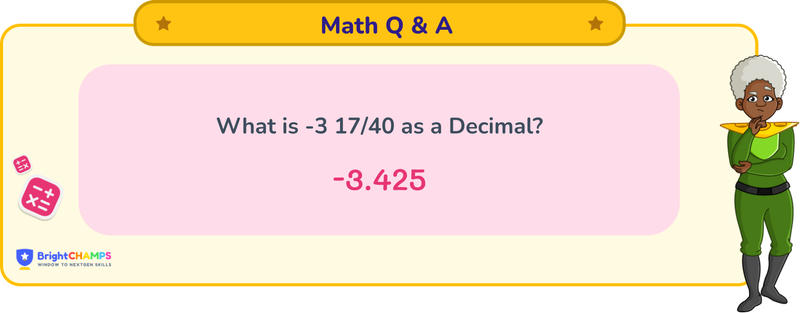
 150 Learners
150 LearnersLast updated on May 26th, 2025

-3 17/40 as a Decimal

It is a simple question on decimal conversion. Firstly, we have to learn fractions and decimals. A fraction represents a part from the whole. It has two parts, numerator (number on the top) here, 17 represents how many parts out of the whole. The denominator (number below) shows how many parts make the whole, here it is 40. A decimal is a way to represent the number that is not whole, using a (.) or a decimal to separate the whole part from the fraction part. The numbers to the left of the decimal point represent the whole, and that to the right represents the fractional part.
What is -3 17/40 as a decimal?
Answer
-3 17/40 in decimals can be written as -3.425.
Explanation
To convert -3 17/40 to a decimal, we need to handle the whole number part and the fractional part separately. Let's see the step-by-step breakdown of the process:
Step 1: Identify the whole number and the fraction. Here, -3 is the whole number, and 17/40 is the fraction.
Step 2: Convert the fraction 17/40 to a decimal by dividing the numerator (17) by the denominator (40).
Step 3: Perform the division: 17 ÷ 40 = 0.425.
Step 4: Combine the whole number with the decimal part. Since the whole number is -3, the decimal is -3.425.
The answer for -3 17/40 as a decimal will be -3.425.
Important Glossaries for -3 17/40 as a decimal
- Mixed Number: A number consisting of an integer and a proper fraction.
- Decimal Conversion: The process of changing a fraction into its decimal form.
- Numerator: The top part of a fraction, indicating how many parts of the whole are being considered.
- Denominator: The bottom part of a fraction, showing how many parts make up a whole.
- Recurring Decimal: A decimal in which a digit or group of digits repeats infinitely.





